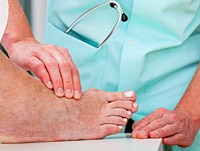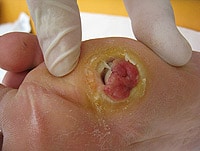SAN FRANCISCO — Results from 2 new studies in diabetes-related foot complications indicate how vital it is for healthcare professionals to adopt a multidisciplinary team approach when it comes to managing this often-neglected complication of diabetes.
The findings were reported at the American Diabetes Association (ADA) 2014 Scientific Sessions earlier this week.
In the first study, a retrospective look back at 10 years of treatment of underserved populations in a single center, Merribeth Bruntz, DPM, from the Denver Health Medical Center, Colorado, reported a staggering reduction in the number of amputations after she established a limb-salvage program in her institution.
In a second presentation, Laura McEwan, PhD, from the University of Ann Arbor, Michigan, described how amputations were significantly associated with death in the Translating Research Into Action for Diabetes (TRIAD) study. Somewhat surprisingly, this applied to minor amputations of the toe and forefoot as well as to major amputations.
Session chair Paul Kim, DPM, from Georgetown University School of Medicine, Washington, DC, toldMedscape Medical News the 2 new studies validate prior findings and point to the importance of developing a national treatment plan for diabetic foot.
"One of the difficulties in diabetic foot care in the US is the lack of a cohesive treatment plan, so everyone does everything differently based on the resources available to them," he explained. There are so many disciplines doing wound care, including physicians, nurses, physical therapists, podiatrists, general surgeons, and different specialists, "that it actually muddies the water a little bit because everybody brings a little bit [of a] different toolbox to the game," he observed.
Hence the need for a uniform, multidisciplinary approach: "If you have the right members, then you have a more comprehensive and cohesive treatment plan for the patient, and if that can be rolled out nationally, I think our amputation numbers will significantly decrease, as demonstrated here by a single institution [in Denver]."
Dr. Kim is hopeful that the establishment of the US National Diabetic Foot Registry, which is about to be launched, will help in this aim. "This is a new incentive just to look at if we are doing things correctly — there's really been no robust registers in the US, anyway, that show that things work or don't work, and that needs to be done so we can improve patient outcomes in general," he said.
"The foot is a neglected area anatomically, but I think it's gaining much more prominence. I was sitting in this session 3 years ago and there were literally 3 or 4 people in the audience, and today you saw it's a little bit more of an interest, not only nationally but globally," he added. "And I think things will improve further with good ambassadors for diabetic foot ulcer care — and we have many, in many different disciplines, who are traveling across the country and across the world discussing this really important and growing issue."
Nothing Fancy: Just Working Together
Dr. Bruntz told how, when she began work in July 2004 as the first podiatrist at Denver Health Medical Center, a safety-net hospital system that serves a diverse patient population, there were no diabetic-foot clinics, no focused model of care for inpatients or outpatients, and no established limb-salvage program, and nearly all amputations were performed by general and orthopedic surgeons.


